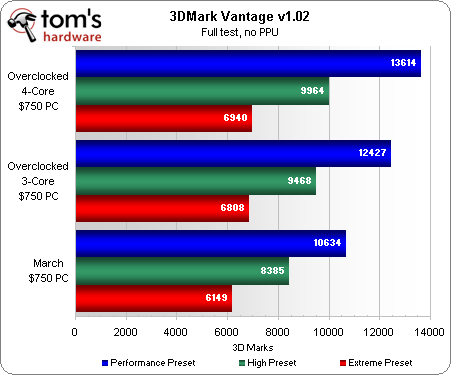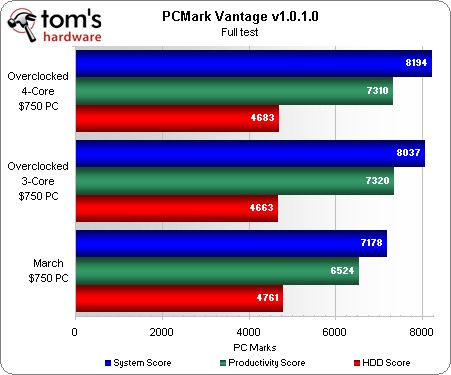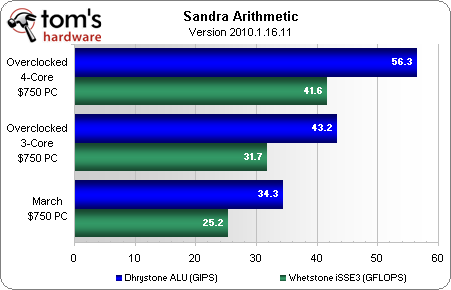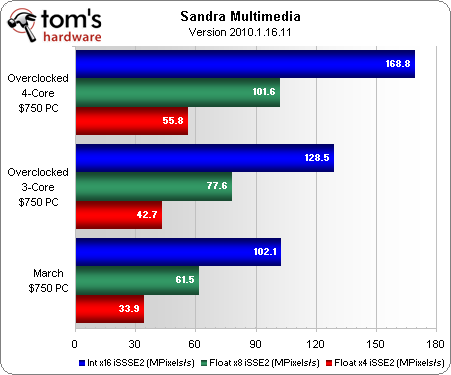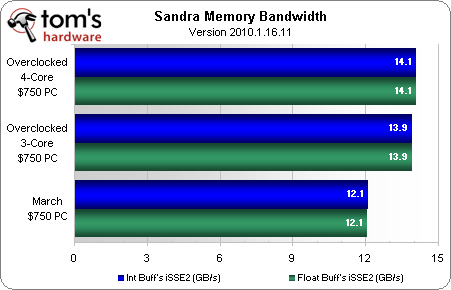System Builder Marathon, March 2010: $750 Gaming PC
Benchmark Results: Synthetics
The test suite has undergone numerous updates for 2010. We didn’t want to overcrowd the charts or mix data from different benchmark versions, but here is another link to the December 2009 $700 SBM PC for readers looking to compare performance to the previous SBM.
Let’s start things out with a look at synthetic benchmarks and then we’ll move onto the new gaming suite.
Overclocking efforts alone achieve a 17% gain at the Performance Preset and an 11% increase in the more GPU-weighted Extreme Preset. Unlocking the fourth core increased the CPU score by about 2,800, amounting to between 130 and 1,200 more overall 3DMarks.
Sporting a stronger pair of graphics cards, the $700 SBM PC from December 2009 still wins the High and Extreme Presets, but the massive increase in CPU scores for the triple and unlocked quad-core Athlon II bring today’s system a victory at the Performance Preset. 3DMark Vantage indicates we now have more processor performance for well-threaded CPU-intensive games, but less graphics power for high-resolution, GPU-intensive games.
Even the stock March $750 SBM PC is able to outpace the overclocked December SBM PC in all three of these PCMark Vantage tests.
Overclocking provides gains in the overall system and productivity score, but not in the HDD score. Unlocking the fourth core provided some benefits in about half of the individual tests, which is reflected by the slight increase in the overall system test.
We stepped up to the 2010 version of Sandra, but see the stock $750 SBM PC achieves Processor Arithmetic and Multimedia scores that are about equal to the overclocked PC from December. Memory bandwidth is a whole different story, as today’s AMD 790GX DDR3-based platform achieved more than double the benchmark results compared to the Intel P45 DDR2-800-based platform from the last round.
The unlocked fourth core provided quite a large boost in the two processor tests, and despite somewhat lower DDR3, HyperTransport, and northbridge frequencies, it even resulted in slightly higher memory bandwidth.
Current page: Benchmark Results: Synthetics
Prev Page Test System Configuration And Benchmarks Next Page Benchmark Results: CrysisGet Tom's Hardware's best news and in-depth reviews, straight to your inbox.
-
erdinger Good job. I Really like the system and I agree in nearly every decision.Reply
unlocking the forth core and still overclocking to 3.6Ghz is just great! I'm getting jealous because my 4th core is broken.
I'm looking forward to the value comparison. -
cruiseoveride This is almost identical to my build. But I used 2nd hand parts, dual HD4870s and it worked out just less than $600.Reply
4 cores, 3.2Ghz, 13,000 3dmark points.
Great bang-for-buck system. -
stray_gator Apart from a SBM entry, this article also provides reality check regarding the benefits of a fourth core. quite useful.Reply -
jsowoc I find the value comparisons are usually (always?) that the least expensive computer has the most "value", followed closely by the middle computer, trailed by the most expensive setup.Reply
Would it be possible to make a 3-way comparison of systems at the same price (for example, $1000)? One could be an AMD-based system, another an Intel-based, and a third maybe a graphics-heavy monster, or a MicroATX system (to see how much performance you sacrifice to stay in $1000 and fit a small form factor). -
Otus What would by interesting is a round of "upgrade" builds. Set specific budgets for ungrades and add them on top of the hardware from a previous round. That would allow commentary on upgrade paths and also help builders of new rigs.Reply -
Crashman jsowocI find the value comparisons are usually (always?) that the least expensive computer has the most "value", followed closely by the middle computer, trailed by the most expensive setup.Would it be possible to make a 3-way comparison of systems at the same price (for example, $1000)? One could be an AMD-based system, another an Intel-based, and a third maybe a graphics-heavy monster, or a MicroATX system (to see how much performance you sacrifice to stay in $1000 and fit a small form factor).Reply
Except for the CPU cooler, you usually sacrifice nothing to go Micro ATX. Tom's Hardware even did a micro-ATX SBM...where the Core i7 system sucked because it had to use the stock cooler. You can find semi-small micro-ATX cases that fit mid-sized coolers.
Antec also makes a MICRO ATX MID TOWER which REALLY sux since it misses the point of Micro ATX completely, so I don't want to hear about that one.
And of course there's Micro ATX mini-towers with the same layout as full-ATX. You get all the performance of ATX and the big cooler, with a case that's around 14-15" tall. -
jsowoc CrashmanExcept for the CPU cooler, you usually sacrifice nothing to go Micro ATX. Tom's Hardware even did a micro-ATX SBM...where the Core i7 system sucked because it had to use the stock cooler. (...)Reply
My argument was not that they should do a $500-$1000-$2000 comparison of uATX builds - they did this. I was suggesting doing a $1000intel - $1000amd - $1000uATX comparison. -
tigerwraith I still dont understand why they went with 2 gfx cards. Ive seen in a lot of reviews that even the newest games dont always work right off the bat when using Crossfire or SLi, So why not spend the money on a 5770 for this. You get DX 11, Dual to Triple moniters, and passthrough. So say you wanted to build a budget HTPC that could game Id have went with the 5770 or 5830 not only would that be a great cpu to watch on a HDTV but you would only need the HDMI cable to run everything.Reply

